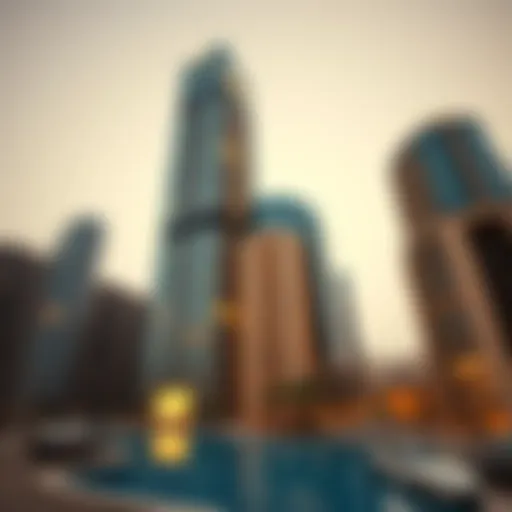Discovering Dubai's Top Destinations and Real Estate
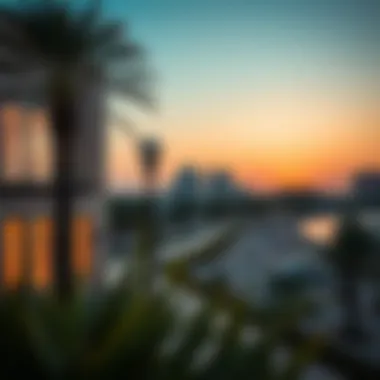

Intro
Dubai, a city of contrasts and contradictions, serves as a canvas for the dreams and aspirations of many. Known for its shimmering skyscrapers and luxurious lifestyle, it also hides pockets of culture and history that offer a different perspective on urban living. This article investigates the remarkable places that shape Dubai's identity, presenting their significance in the real estate market.
From the awe-inspiring Burj Khalifa, which towers over the cityscape, to the vibrant communities emerging in Dubai's outskirts, this narrative will navigate through each area's unique attributes. The importance of understanding these locations extends beyond mere appreciation; it encompasses strategic insight for potential residents and investors seeking a foothold in this dynamic market. As we delve deeper, we will uncover not just famous landmarks, but also lesser-known treasures that contribute to the eclectic urban landscape of Dubai.
Through careful analysis, we will explore how current property trends and future projections affect the real estate scene. By the end of this guide, readers will gain a nuanced understanding of the opportunities that lie within these remarkable spaces, as well as practical advice on navigating the market.
As they say, "It's not what you look at that matters, it's what you see." So, let’s embark on this enlightening journey through the exceptional locations of Dubai, uncovering insights that go well beyond its glittering surface.
Preface to Dubai's Landmarks
Dubai, a city that effortlessly melds the old with the new, is a real estate sanctuary packed with landmarks that reflect its remarkable growth. Recognizing the significance of its landmarks means appreciating how they embody the essence of Dubai itself. From towering skyscrapers to quirky galleries and traditional markets, each location plays a pivotal role in contributing to the city's vibrant identity.
Understanding these landmarks is essential for various stakeholders, especially for real estate agents, investors, homebuyers, developers, and analysts. They offer valuable insights into the city's cultural fabric and growth potential. Furthermore, they encourage tourists, which in turn stimulates commerce, making these sites not just visually appealing but also economically significant. An exploration of these renowned locations reveals how Dubai’s real estate sector is intertwined with its architectural feats. No prize for guessing that investors frequently scout areas near these landmarks, which brings about a promising potential for property valuations in the area.
In this section, we delve into two fundamental aspects: the nuanced cultural tapestry of the city and how it echoes through its architectural choices, and the marriage of tradition and modernity that is exhibited in its landmarks. Understanding these layers provides a thorough grasp of what makes Dubai not just a destination, but a living canvas of continuous evolution.
Iconic Structures
When one thinks of Dubai, it’s hard not to picture its impressive tall towers and luxurious buildings. These iconic structures are not just architectural marvels; they encapsulate the spirit, ambition, and innovation that Dubai represents. This section will delve into three standout icons—the Burj Khalifa, Burj Al Arab, and the Dubai Mall—and explore their significance in the landscape of real estate and tourism in such a vibrant city.
Burj Khalifa: A Pinnacle of Engineering
The Burj Khalifa stands tall as the tallest building in the world, reaching a staggering height of 828 meters. It’s not merely a construction feat; it symbolizes what Dubai has accomplished over the years. Designed by the architect Adrian Smith, this skyscraper took six years to complete, opening its doors in 2010.
- Architectural Significance: The design draws inspiration from Islamic architecture, offering a blend of tradition and modern engineering. Its Y-shaped floor plan helps reduce wind loads, showcasing the thoughtful engineering behind its construction.
- Tourism Magnet: Inside, visitors flock to the observation deck on the 148th floor, offering breathtaking views of the city and beyond. This experiential aspect has cemented its reputation, making it a must-visit for anyone who sets foot in Dubai.
- Real Estate Implications: Surrounding the tower, Downtown Dubai has burgeoned into a hotbed for luxury apartments and high-end retail spaces, greatly enhancing property values in the area.
Burj Al Arab: The Tower of Luxury
Rising dramatically from its own artificial island, the Burj Al Arab is often referred to as "the world's only seven-star hotel." Its distinctive sail-shaped silhouette is instantly recognizable and embodies the opulence that Dubai is known for.
- Luxury Redefined: This hotel refuses to compromise on luxury. Guests enjoy exceptional amenities, including a helipad, personal butlers, and lavish suites that would impress the most discerning travelers. This focus on luxury attracts affluent tourists and drives the local economy.
- Cultural Landmark: Beyond just a place to stay, the Burj Al Arab is an architectural icon featured in numerous advertisements, films, and media, reinforcing Dubai's image as a global luxury hotspot.
- Local Impact: Its presence has spawned a surge of investment in surrounding properties, positioning the area as a prime location for both tourism and high-end residential real estate.
Dubai Mall: A Shopper's Paradise
Spanning over 1.1 million square meters, the Dubai Mall is not just a shopping complex; it’s an entire experience. Home to over 1,200 retail stores, it attracts millions of visitors each year, making it one of the most visited shopping destinations in the world.
- Diversified Offerings: Aside from shopping, visitors can enjoy an aquarium, an ice skating rink, and numerous dining experiences. The mall has created an immersive environment, taking the shopping experience to a whole new level.
- Economic Growth: As a major commercial hub, the Dubai Mall has not only affected retail but also positively impacted the local real estate market. Properties nearby have seen significant growth in demand due to the mall's allure.
- Community Hub: The mall also hosts various events and exhibitions year-round, reinforcing its role as a community center in Dubai.
In essence, these iconic structures are more than just buildings. They are integral to the narrative of Dubai's growth, reflecting aspirations and providing a sense of place in a city that continues to evolve.
As we peel back the layers of Dubai, it's clear that these architectural wonders serve as benchmarks for both the cultural identity of the city and its booming real estate market.
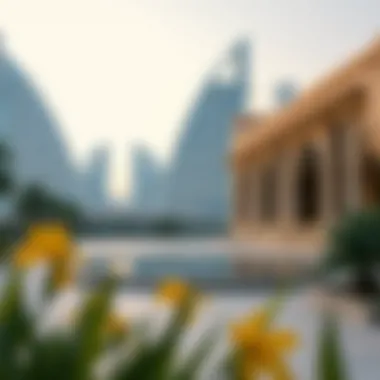

Exploring Unique Neighborhoods
Diving into the essence of Dubai requires a close examination of its unique neighborhoods. Each area tells a story, capturing the diverse demographics and cultural nuances that shape the city. From bustling urban landscapes to serene waterfronts, these neighborhoods reveal the multifaceted character of Dubai. Understanding these spaces is beneficial not only for prospective residents but also for investors seeking to capitalize on emerging opportunities in the real estate market.
Downtown Dubai: Urban Living at Its Finest
Nestled in the heart of Dubai, Downtown Dubai stands out as an epitome of urban sophistication. Home to the iconic Burj Khalifa, this area is synonymous with modern luxury. The skyscrapers and vast shopping arenas draw both tourists and residents alike, creating a vibrant community pulse that doesn’t skip a beat. Yet, beyond the glitz lies an important aspect to consider—the residential options available.
- Accessibility: Downtown Dubai offers fantastic transport links, making commutes a breeze. The Dubai Metro connects residents to other key city locations.
- Amenities: From high-end restaurants to leisurely parks, amenities abound in Downtown Dubai. Residents enjoy easy access to the grandeur of Dubai Mall, which isn’t just a shopping destination but a place for social gatherings and events.
- Cultural Events: This neighborhood frequently hosts cultural festivals and events, showcasing art, music, and cuisine from around the globe.
Dubai Marina: A Waterfront Haven
The Dubai Marina is a striking juxtaposition of modern cast against a backdrop of natural beauty. Stretching alongside the Arabian Gulf, it offers mesmerizing views that make it popular amongst expatriates. Living here means waking up to the nautical charm and lively vibe.
- Lifestyle: The lifestyle here is marked by luxury. Upmarket apartments overlook the marina, and waterfront dining experiences are second to none.
- Recreational Opportunities: For the active types, the marina offers various water sports, from jet-skiing to sailing, allowing for a lifestyle that many dream of. The nearby JBR beach also provides endless opportunities for relaxation.
- Investment Potential: Given the appeal of its waterfront, Dubai Marina continues to be a hotspot for real estate investment. As demand grows, so does the potential for property value appreciation, making it a sound choice for investors.
Jumeirah: Coastal Elegance
Jumeirah embodies the essence of coastal elegance and is often seen as one of the most desirable areas in Dubai. This district is not only known for its luxurious villas but also for its family-friendly environment.
- Scenic Beauty: With pristine beaches and the iconic Burj Al Arab, Jumeirah allows residents a unique beachfront lifestyle. The sea breeze complements the upscale atmosphere, making outdoor living enjoyable.
- Community Feel: Unlike the bustling urban landscapes, Jumeirah presents a more relaxed community vibe. This blend of tranquility and luxury caters to families and individuals looking for a peaceful yet opulent lifestyle.
- Cultural Institutions: The neighborhood is home to several cultural institutions, including art galleries and museums, that provide cultural enrichment to its residents.
In summary, exploring these unique neighborhoods—Downtown Dubai, Dubai Marina, and Jumeirah—not only highlights the distinctive characteristics each area offers but also provides a roadmap for navigating Dubai’s real estate landscape. Each neighborhood shines in its own right, catering to a variety of preferences and lifestyles, contributing to the allure of this remarkable city.
Natural Attractions
Natural attractions in Dubai offer a refreshing contrast to the city’s skyscrapers and urban sprawl. While the modern architecture and bustling activity are impressive, it's crucial to understand how these natural experiences contribute to the overall allure of the city. Not only do they attract tourists seeking beauty and adventure, but they also serve as significant selling points for investors and homebuyers looking for a balanced lifestyle.
Among the benefits of these natural attractions is their role in promoting wellness and leisure activities. Places like parks and gardens provide a reprieve from the hustle and bustle, allowing residents to unwind and connect with nature. Furthermore, such spaces often enhance property values, making them appealing for those interested in real estate. Moreover, they offer opportunities for various recreational activities, which can draw in both tourists and locals, increasing economic potential in surrounding areas.
The Miracle Garden: A Floral Wonderland
The Miracle Garden is a breathtaking spectacle that captivates visitors with its vibrant floral displays. Opened in 2013, this garden is home to over 50 million flowers, arranged in unique designs and patterns. Spanning 72,000 square meters, it is the largest flower garden in the world, showcasing a variety of species that bloom in a dazzling array of colors.
The significance of the Miracle Garden extends beyond its aesthetic appeal. It serves environmental goals, encouraging sustainability through innovative gardening techniques and promoting biodiversity. Visitors often describe the experience as walking through a fairy tale, where the scent of blossoms fills the air, and the vibrant hues seem to dance in the sunlight.
- Key Features of the Miracle Garden:
- Floral Sculptures: Iconic displays such as the Emirates A380 aircraft and heart-shaped arches catch the eye.
- Seasonal Themes: The garden changes its floral arrangements with the seasons, ensuring that no two visits are ever the same.
- Family-Friendly Environment: With picnic spots and cafes, it's an ideal place for families to spend the day together.
The Miracle Garden is not just a place to visit; it’s a statement about Dubai's commitment to integrating natural beauty within its urban framework.
Desert Adventures: Experience the Dunes
Venturing into the desert presents a different side of Dubai that few can resist. The vast expanse of golden dunes offers an unparalleled backdrop for adventure seekers. Activities such as dune bashing, sandboarding, and camel rides are popular among tourists and locals alike, fostering a spirit of exploration.
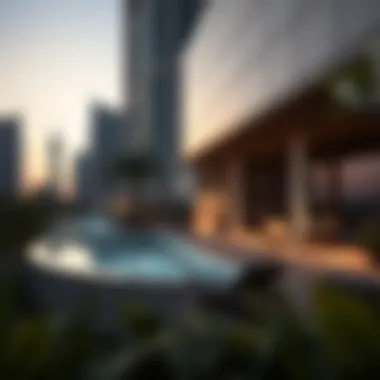

However, the allure of the desert isn’t purely recreational. This stark landscape is also economically important for tourism. Tourists typically gravitate towards guided safaris, which incorporate traditional experiences like henna painting and cultural shows featuring local music and dance. Such experiences not only enrich visitor engagement but also provide a revenue stream for the local economy.
"Experiencing the desert is like a rite of passage in Dubai, offering a glimpse into the natural beauty that surrounds this modern oasis."
In terms of real estate, properties situated near desert landscapes can be appealing to those who appreciate tranquility and scenic views. As such, the desert plays a significant role in attracting investments in adjacent developments, enhancing the value of properties by providing a unique lifestyle choice.
Natural attractions, like the Miracle Garden and the desert, enrich Dubai's identity. They combine recreation, aesthetics, and economic potential, making them integral to both the culture and real estate landscape of this dynamic city.
Cultural Landmarks
Cultural landmarks in Dubai offer a scenic blend of the old and the new, showcasing the rich history and traditions of the city. These destinations do not just serve as tourist spots, but also reflect the identity and evolution of Dubai over the years. Understanding these landmarks can be crucial for real estate agents, investors, and developers who seek to appreciate the local context as it can influence market trends. Investing in areas around these culturally significant locations often presents both a unique character and potential growth in property values.
These landmarks represent the soul of Dubai, giving a glimpse into the life and struggles of its inhabitants throughout the ages. Moreover, they create a robust platform for cultural tourism, which is essential for economic sustainability. Here’s a closer look at two significant cultural landmarks that embody the essence of Dubai:
Dubai Museum: A Glimpse into the Past
Located in the heart of the city, the Dubai Museum is housed within the Al Fahidi Fort, naturally merging history with a modern twist. Initially built in 1787, the fort is the oldest existing building in Dubai, and the museum is a treasure trove of local heritage. Visitors can step back in time as they explore a range of exhibits that showcase the traditional way of life in the Emirate, from fishing and pearl diving to the essential trade routes that shaped the region.
The museum’s immersive presentations include dioramas and film projections, offering insight into Dubai's transformation from a small fishing village to a global metropolis. This historical richness serves as an anchor point, making the area of Bur Dubai a significant investment zone.
Key insights about the Dubai Museum include:
- Location: Al Fahidi Fort, Bur Dubai
- Visiting Hours: Generally open from 8:30 AM to 8:30 PM
- Admission Fee: Minimal fee; promoting accessibility and engagement
Through these attributes, the museum plays a pivotal role in attracting not only tourists but also local residents who gain a deeper appreciation for their homeland’s past.
Al Fahidi Historical Neighborhood: Heritage in Modernity
Just adjacent to the museum, the Al Fahidi Historical Neighborhood is a testament to Dubai's commitment to preserving its cultural heritage amid rapid modernization. The narrow lanes lined with wind-tower architecture tell tales of a bygone era, as they used to serve as natural air conditioning before the advent of electricity.
Wandering through this neighborhood feels like stepping into an artful dialogue between past and present. The area is home to numerous art galleries, museums, and cafes that are tucked away in restored buildings, making it a cultural hub. Events like the annual Al Bastakiya Arts Festival highlight this blend of art and heritage, attracting a diverse audience.
Real estate professionals should also note that this rejuvenated locality has become increasingly popular among artists and creative minds, leading to a rise in demand for properties in the vicinity.
Important aspects of Al Fahidi Historical Neighborhood include:
- Cultural Events: Frequent art and culture festivals
- Architectural Significance: Preserved traditional wind-tower buildings
- Investment Potential: Emerging area for art studios and boutique hotels
In summary, understanding these cultural landmarks is vital not only for appreciating Dubai's narrative but also for recognizing the potential they hold in shaping real estate opportunities. By learning the story behind the museum and the Al Fahidi neighborhood, investors can better assess their potential impact on property valuation and urban development in the region.
Investment Potential in Key Areas
The investment landscape in Dubai is a tapestry woven with opportunities, particularly in key areas that show promise for growth and prosperity. This section explores why understanding these investment potentials is crucial, especially for real estate agents, investors, homebuyers, developers, and analysts. With a population expanding steadily, government initiatives fostering economic diversity, and a lifestyle that attracts expatriates from across the globe, the city presents a robust platform for investment.
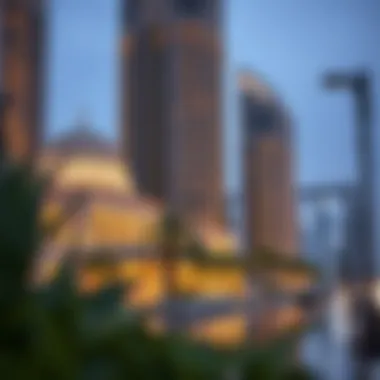

Investors must tread the terrain of real estate with a keen eye on emerging markets and demand trends. Areas that are undergoing development, like supply and demand for residential and commercial spaces, are vital indicators of where to lay your investments.
Here are the specific elements and benefits to consider when eyeing the investment potential in Dubai’s neighborhoods:
- High ROI: The potential for a substantial return on investment is increasingly strong in Dubai. With rental yields often outpacing global averages, investors can expect attractive returns.
- Economic Stability: Dubai's economy has shown resilience, and the government's commitment to enhancing infrastructure and investment in tourism and technology ensures ongoing growth.
- Diverse Market: The metropolitan fabric of Dubai includes various demographics, from luxury seekers to budget-conscious families, ensuring a steady demand across sectors.
Now let's delve into the Emerging Neighborhoods that are ripe for taking advantage of this investment potential.
Emerging Neighborhoods: Opportunities for Investors
In recent years, several neighborhoods have been quietly transforming into hotbeds for real estate investment, paving the way for future growth. Among these areas, locations such as Dubai South, Jumeirah Village Circle, and Dubai Creek Harbour are gaining traction. Each of these neighborhoods presents unique advantages:
- Dubai South: Positioned as the future site for the Expo 2020, this area is already in the making for residential, commercial, and logistical spaces. Investors can bank on the anticipated growth that will come from the influx of people and businesses.
- Jumeirah Village Circle (JVC): Known for its affordability and community feel, JVC is attracting a younger demographic along with families looking for spacious living at competitive prices. A surge in amenities, schools, and parks has increased its allure as a prime location.
- Dubai Creek Harbour: This area combines luxury and leisure with a vision of sustainability. The promise of these futuristic designs makes it appealing for long-term investment, especially as the world turns its eye toward eco-friendly developments.
There are opportunities aplenty. However, investors must also keep considerations in mind:
- Market Fluctuations: The real estate market can fluctuate; hence, due diligence is essential. Understanding local trends and potential risks can keep investments safe.
- Regulatory Environment: Familiarity with Dubai’s property laws and regulations ensures compliance and helps investors to avoid complications that could arise.
Property Trends in Prominent Locations
It’s interesting to see how certain areas exemplify evolving trends in real estate. Property trends can shape the investment narrative in discerning locations like Downtown Dubai and Dubai Marina.
- Downtown Dubai: This iconic region is home to landmarks such as the Burj Khalifa. Demand for high-end apartments remains bullish due to continued interest from both local and international buyers. Notably, luxury properties witnessing significant demand can lead to increased rental prices and continued appreciation in value.
- Dubai Marina: While traditionally a hub for expatriates, the area is seeing a shift in demographics as younger professionals seek more modern and flexible living spaces. Offers of waterfront views and lifestyle appeal are driving the rental market upward, making it a frequent hotspot for both short-term and long-term leases.
Keeping an eye on these trends equips potential investors with valuable insights, helping them decide where to allocate their resources effectively.
The potential for profit in Dubai’s evolving neighborhoods is like finding a diamond in the rough. One just needs the right tools and knowledge to uncover it.
For more insights, you may refer to resources like Wikipedia, or check out discussion threads on Reddit for the latest on property news and trends.
Culmination: The Ever-Evolving Landscape of Dubai
As we wrap up our exploration of Dubai, it's clear that the city's transformation is relentless and fascinating. Dubai isn't just a destination; it’s a concept that continues to evolve, marked by innovation and ambition. The ongoing development projects and architectural feats signify more than just economic prosperity; they portray a vision that beckons investors, homebuyers, and travelers alike to be part of its remarkable journey.
Future Prospects for Dubai's Real Estate
The potential of Dubai's real estate market in the coming years is promising. The city is proactively enhancing its infrastructure, with significant investments in transport and amenities that bolster its livability. Current trends favor mixed-use developments, which blend residential, commercial, and leisure spaces, appealing to the diverse lifestyles of residents.
A few factors propelling future growth include:
- Sustainable urban planning: With a focus on environmentally friendly practices, Dubai aims to cultivate green spaces that support community well-being.
- Government incentives: Recent policies encourage foreign investment, allowing non-residents to purchase property in designated areas, making it a hotspot for international buyers.
- Tourism expansion: Events like Expo 2020 (now extended) and ongoing efforts to boost leisure and entertainment offerings are likely to further enhance property values.
Investors should keep an eye on emerging neighborhoods that are shifting dynamics, such as Dubai South and Al Furjan, where the demand is gradually rising.
Final Thoughts on Dubai's Appeal
Dubai encapsulates a living narrative of growth and luxury that extends beyond its glimmering skyline. It's a city that successfully marries tradition with cutting-edge innovation. The allure of expat-friendly policies, vibrant culture, and a cosmopolitan lifestyle continues to attract a myriad of nationalities.
The city's diversity is palpable, providing a unique tapestry of experiences that cater to everyone. From luxury shopping in Dubai Mall to the cultural depth of Al Fahidi Historical Neighborhood, there's a striking contrast that adds layers to its appeal.
In summary, Dubai remains a beacon of opportunity and sophistication. Its landscape is constantly shifting, making it more than just a place to live or invest—it's a lifestyle, a community, and above all, an adventure waiting to unfold. As the city prepares for the future, its vibrant essence ensures that it will remain a top contender in the global market.















